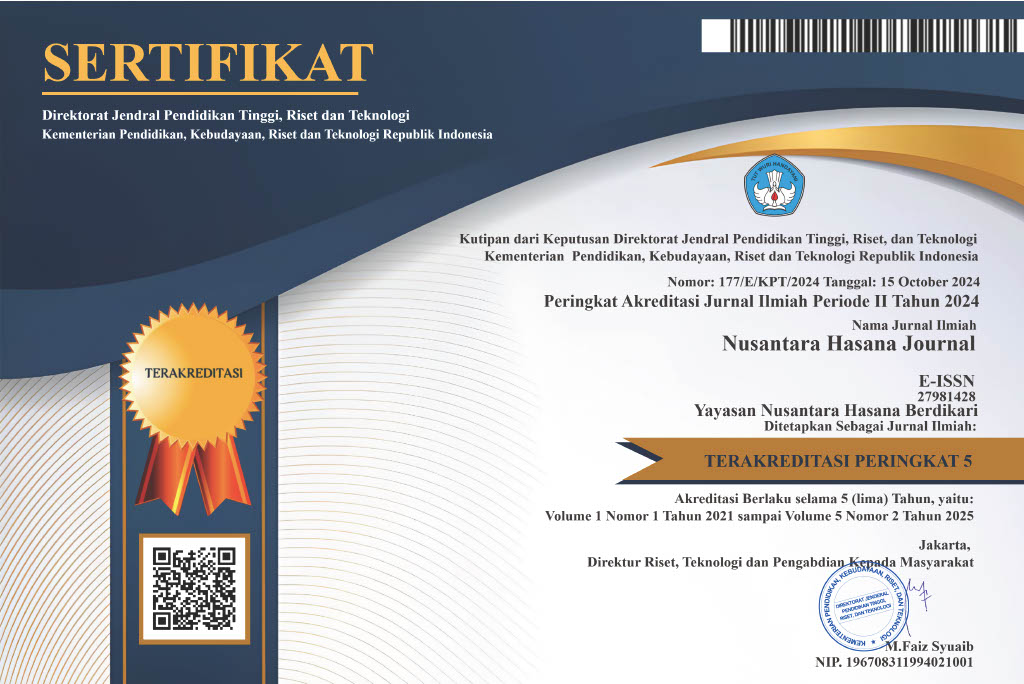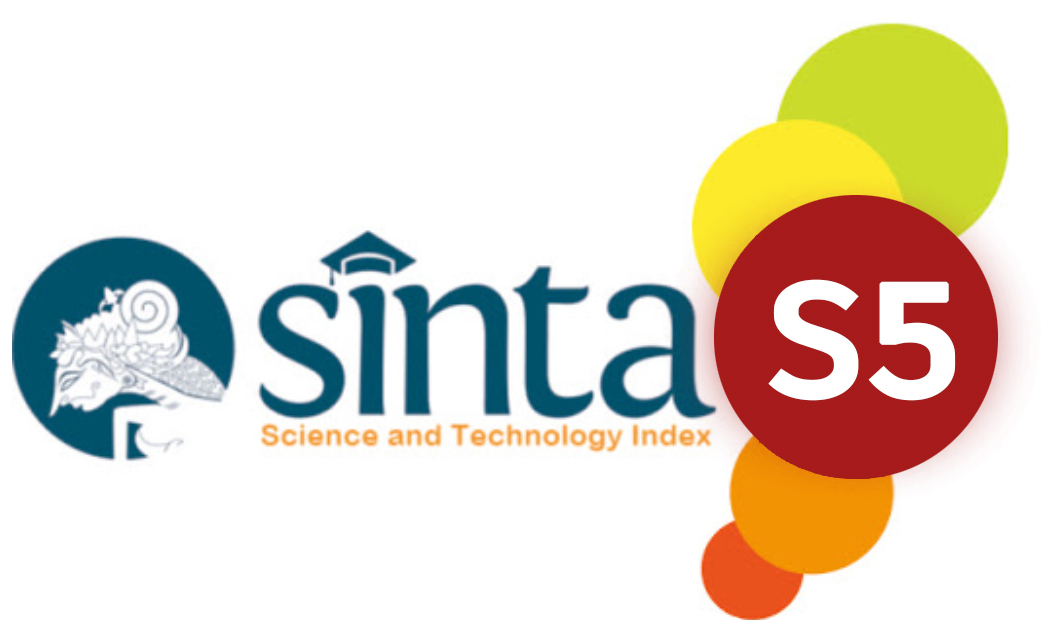HUBUNGAN PERSEPSI SISWA SMA NEGERI 1 ARGA MAKMUR TERHADAP PENCEGAHAN COVID-19
DOI:
https://doi.org/10.59003/nhj.v3i4.1284Keywords:
gender, perceptions and attitudes, Prevention of COVID-19Abstract
Since it first appeared at the end of 2019, the Novel coronavirus disease 19 (COVID-19) was officially declared a global pandemic by the World Health Organization (WHO) on March 11, 2020 and WHO urges the government to oblige its people to implement protective behavior to prevent transmission and the spread of COVID-19. Before making an action, humans tend to perceive something as good or positive perceptions or negative perceptions that will influence their actions and based on the Health Belief Model (HBM), people will change their behavior if they understand that the disease is serious, otherwise they may not switch to behavior which is healthy. Methods: This type of research is a correlative analytic study with a cross-sectional approach. The affordable population in this study were students of SMA Negeri 1 Arga Makmur Bengkulu Utara with 267 samples. Univariate data analysis is presented in the form of frequency distribution and percentage and bivariate analysis using the kruskall-wallis test and data processing using a computerized SPSS version 25.0 program. The most respondents were female, namely 178 people (66.7%), the most respondents with a sufficient perception of vulnerability were 194 people (72.7%), the most respondents with a good perception of severity were 147 people (55.1% ), the most respondents with a good perceived benefit were 217 people (81.3%), the most respondents with a sufficient perception of obstacles were 212 people (79.4%), the most respondents with a good perception of cues were 227 people (85.0 %), and the most respondents with a good self-efficacy perception were 231 people (86.5%), the most respondents had a good attitude, namely 166 people (62.2%), there was a relationship between perceptions of vulnerability of students of SMA Negeri 1 Arga Makmur to attitudes. prevention of COVID-19 (p = 0,000), there is no relationship between the perception of severity of SMA Negeri 1 Arga Makmur students on attitudes to prevention of COVID-19 (p = 0.077), there is a relationship between perceived benefits of students of SMA Negeri 1 Arga Makmur on attitudes towards preventing COVID-19 (p = 0.012), there is a relationship the perception of barriers of SMA Negeri 1 Arga Makmur students towards attitudes towards prevention of COVID-19 (p = 0,000), there is a correlation between the perception of cues of SMA Negeri 1 Arga Makmur students on attitudes to prevention of COVID-19 (p = 0,000) and there is a correlation between the perception of self-efficacy of high school students Negeri 1 Arga Makmur on the attitude of preventing COVID-19 (p = 0,000). There is a relationship between perceptions of vulnerability, perception of barriers, perception of cues, perceived benefits and perceptions of self-efficacy and there is no relationship between perceptions of severity of SMA Negeri 1 Arga Makmur students on attitudes to prevention of COVID-19.
Downloads
References
Bach Xuan Tran, Giang Hai Ha, Long Hoang Nguyen. 2020. Studies of Novel Coronavirus Disease 19 (COVID-19) Pandemic: A Global Analysis of Literature. International Journal of Environmental Research and Public Health.
WHO Coronavirus Disease (COVID-19) Dashboard. 2020. World Health Organization. 28 Oktober 2020.
José Manuel Hernández-Padilla, José Granero-Molina,María Dolores Ruiz-Fernández. 2020. Design and Psychometric Analysis of the COVID19 Prevention, Recognition and Home-Management Self- Efficacy Scale. International Journal of Environmental Research and Public Health.
Ratna Setiyaningsih, Didik Tamtomo, Nunuk Suryani. 2016. Health Belief Model: Determinantsof Hypertension Prevention BehaviorinAdults at Community Health Center, Sukoharjo, Central Java. Journal of Health Promotion and Behavior, 1 (3): 161-171.
Ali Khani Jeihooni, Alireza Hidarnia, Mohammad Hossein Kaveh, Ebrahim Hajizadeh. 2015. The Effect of a Prevention Program Based On Health Belief Model on Osteoporosis. Journal of Research in Health Sciences, 15 (1): 47-53.
Sonia Mukhtar. 2020. Mental health and emotional impact of COVID-19: Applying Health Belief Model for medical staff to general public of Pakistan. Brain, Behavior, and Immunity, 87: 28-29.
Panduan Penyelenggaraan Pembelajaran Pada Tahun Ajaran 2020/2021 Dan Tahun Akademik 2020/2021 Di Masa Pandemi Coronavirus Disease 2019 (Covid-19). Keputusan Bersama 4 Menteri; Menteri Pendidikan dan Kebudayaan, Menteri Agama, Menteri Kesehatan, dan Menteri Dalam Negeri.
Lin L, Li TS. 2020. Interpretation of guidelines for the diagnosis and treatment of novel coronavirus (2019-nCoV) infection by the National Health Commission (trial version 5). Zhonghua Yi Xue Za Zhi 100: E001.
Sarwono, S. 2010. Pengantar Psikologi Umum. Jakarta: Raja Grafindo Persada.
Hao W, Li M, Huang X. 2020. First atypical case of 2019 novel corona virus in Yan’an,China. Clin Microbiology Infection.
Kampf G. 2020. Potential role of inanimate surfaces for the spread of coronaviruses and their inactivation with disinfectant agents. Infection Prevention in Practice 2020.
WHO. 2020. Modes of transmission of virus causing COVID-19: implications for IPC precaution recommendations.
Alonso WJ, Nascimento FC, Shapiro J. 2013. Facing ubiquitous viruses: when hand washing is not enough. Clin Infect Dis, 56: 617.
Jane Ogden. Health Psychology: A textbook. Third Edition. British Library.
Shelley E.Taylor. 2018. Health Psychology. Tenth Edition. University of California. Los Angeles.
World Health Organization. WHO remains firmly committed to the principles set out in the preamble to the Constitution.
Undang-Undang Republik Indonesia Nomor 36 Tahun 2009 Tentang Kesehatan.
Nancy K. Janz and Marshall H. Becker. The Health Belief Model: A Decade Later. Health Education Quarterly Spring., 11 (1).
Mark Conner and Paul Norman. Predicting Health Behaviour: Research and Practice with Social Cognition Models. Second edition.
Kamus Besar Bahasa Indonesia Daring.
Rodriguez-Morales AJ, Bonilla-Aldana DK, Balbin- Ramon GJ, Rabaan AA, Sah R, Paniz-Mondolfi A, Pagliano P, Esposito S. 2020. History is repeating itself: probable zoonotic spillover as the cause of the 2019 novel coronavirus epidemic. Infez Med, 28: 3–5.
Deepak Pradhan,a Prativa Biswasroy,a Pradeep Kumar Naik,b Goutam Ghosh,a and Goutam Ratha. A Review of Current Interventions for COVID-19 Prevention. Archives of Medical Research, 51: 363-374.
Rahmet, İmran, Firdevs. Aktaş. Covid-19: Prevention and control measures in community. Turkish Journal of Medical Sciences, 50: 571-577.
Karen Glanz Barbara K. Rimer K. Viswanath. Health Behaviour and Health Education Theory, Research, and Practice. Champion Celette Sugg Skinner: 45-62.
Wertz PW. 2018. Lipids and the Permeability and Antimicrobial Barriers of the Skin. Lipids: 1e7.
Zhu N, Zhang D, Wang W, Li X, Yang B, Song J, Zhao X, Huang B, Shi W, Lu R, Niu P, Zhan F, Ma X, Wang D, Xu W, Wu G, Gao GF, Tan W. 2020. A novel coronavirus from patients with pneumonia in China, 2019. N Engl J Med, 382: 727–733.
Chen Y, Liu Q, Guo D. 2020. Emerging coronaviruses: genome structure, replication, and pathogenesis. J Med Virol, 92: 418–423.
Li G, Fan Y, Lai Y, Han T, Li Z, Zhou P, Pan P, Wang W, Hu D, Liu X, Zhang Q, Wu J. 2020. Coronavirus infections and immune responses. J Med Virol, 92:424–432.
Lai MMC, Holmes KV. 2001. Coronaviridae: the viruses and their replicatio. In Knipe DM, Howley PM, Griffin DE, Lamb RA, Martin MA, Roizman B, Straus SE (ed), Fields virology, 4th ed. Lippincott-Raven, Philadephia, PA.
Woo PC, Lau SK, LamCS, Lau CC, Tsang AK,Lau JH,Bai R,Teng JL, Tsang CC, Wang M, Zheng BJ, Chan KH, Yuen KY. 2012. Discovery of seven novel mammalian and avian coronaviruses in the genus deltacoronavirus supports bat coronaviruses as the gene source of alphacoronavirus and betacoronavirus and avian coronaviruses as the gene source of gammacoronavirusand delta corona virus. J Virol, 86: 3995–4008.
Cheng VC, Lau SK, Woo PC, Yuen KY. 2007. Severe acute respiratory syndrome coronavirus as an agent of emerging and reemerging infection. Clin Microbiol Rev, 20: 660–694.
Kuldeep Dhama,Sharun Khan, Ruchi Tiwari. 2020. Clinical Microbiology Reviews:Coronavirus Disease 2019–COVID-19. American Society for Microbilogy, 33 (4).
Xiao K, Zhai J, Feng Y, Zhou N, Zhang X, Zou JJ, Li N, Guo Y, Li X, Shen X, Zhang Z, Shu F, Huang W, Li Y, Zhang Z, Chen R-A, Wu Y-J, Peng S-M, Huang M, Xie W-J, Cai Q-H, Hou F-H, Liu Y, Chen W, Xiao L, Shen Y. 2020. Isolation and characterization of 2019-nCoV like coronavirus from Malayan pangolins.
Chan JF, Kok KH, Zhu Z, Chu H, To KK, Yuan S, Yuen KY. 2020. Genomic characterization of the 2019 novel human pathogenic coronavirus isolated from a patient with atypical pneumonia after visiting Wuhan. Emerg Microbes Infect., 9: 221-236.
Hu B, Ge X, Wang LF, Shi Z. 2015. Bat origin of human coronaviruses. Virol J., 12: 221.
Li B, Si HR, Zhu Y, Yang XL, Anderson DE, Shi ZL, Wang LF, Zhou P. 2020. Discovery of bat corona viruses through surveillance and probe capturebased next-generation sequencing. mSphere 5: e00807-00819.
Belouzard S, Millet JK, Licitra BN, Whittaker GR. 2012. Mechanisms of coronavirus cell entry mediated by the viral spike protein. Viruses, 4: 1011-1033.
Schoeman D, Fielding BC. 2019. Coronavirus envelope protein: current knowledge. Virol J, 16: 69.
Nieto-Torres JL, DeDiego ML, Verdiá-Báguena C, Jimenez Guardeño JM, Regla-Nava JA, Fernandez-Delgado R, Castaño- Rodriguez C, Alcaraz A, Torres J, Aguilella VM, Enjuanes L. 2014. Severe acute respiratory syndrome coronavirus envelope protein ion channel activity promotes virus fitness and pathogenesis. PLoS Pathog, 10: e1004077.
Pervushin K, Tan E, Parthasarathy K, Lin X, Jiang FL, Yu D, Vararattanavech A, Soong TW, Liu DX, Torres J. 2009. Structure and inhibition of the SARS coronavirus envelope protein ion channel. PLoS Pathog, 5: e1000511.
Ison MG, Hirsch HH. 2019. Community-acquired respiratory viruses in transplant patients: diversity, impact, unmet clinical needs. Clin Microbiol Rev, 32: e00042-19.
Chen J. 2020. Pathogenicity and transmissibility of 2019-nCoV-A quick overview and comparison with other emerging viruses. Microbes Infect, 22: 69-71.
Nishiura H, Kobayashi T, Yang Y, Hayashi K, Miyama T, Kinoshita R, Linton NM, Jung SM, Yuan B, Suzuki A, Akhmetzhanov AR. 2020. The rate of underascertainment of novel corona virus (2019-nCoV) infection: estimation using Japanese passengers data on evacuation flights. J Clin Med, 9: 419.
Sanchez JL, Cooper MJ, Myers CA, Cummings JF, Vest KG, Russell KL, Sanchez JL, Hiser MJ, Gaydos CA. 2015. Respiratory infections in the U.S. military: recent experience and control. Clin Microbiol Rev, 28: 743-800.
Shen K, Yang Y, Wang T, Zhao D, Jiang Y, Jin R, Zheng Y, Xu B, Xie Z, Lin L, Shang Y, Lu X, Shu S, Bai Y, Deng J, Lu M, Ye L, Wang X, Wang Y, Gao L. 2020. Diagnosis, treatment, and prevention of 2019 novel coronavirus infection in children: experts’ consensus statement. World J Pediatr, 7: 1-9.
Zou L, Ruan F, Huang M, Liang L, Huang H, Hong Z, Yu J, Kang M, Song Y, Xia J, Guo Q, Song T, He J, Yen HL, Peiris M, Wu J. 2020. SARS-CoV-2 viral load in upper respiratory specimens of infected patients. N Engl J Med, 382: 1177-1179.
Sugihartono. 2007. Psikologi Pendidikan. Yogyakarta: UNY Pers.
Hamner, W. Clay & Organ, Dennis W. 1978. Organizational Behavior: An Applied Psychological Approach. Dallas, Texas: Business Publications, Inc.
Bimo Walgito. 2002. Pengantar Psikologi Umum. Yogyakarta: Andi Offset.
Wood, Julia T. 2013. Komunikasi Interpersonal Interaksi Keseharian. Edisi 6. Jakarta: Salemba Humanika.
Wardani, I K dan Hariastuti R T. 2009. Mengurangi Persepsi Negatif Siswa tentang Konselor Sekolah dengan Strategi Pengubahan Pola Pikir Cognitive Restructuring. Jurnal Psikologi Pendidikan dan Bimbingan, 10 (2).
Gusti Nilasari. 2016. Persepsi Mahasiswa Fakultas Kedokteran Universitas Muhammadiyah Palembang Angkatan 2012 dan 2013 terhadap Kinerja Tutor dalam pelaksanaan tutorial PBL di FK UMP. Skripsi. Palembang: Fakultas Kedokteran Universitas Muhammadiyah Palembang.
Wulandari A, Rahman F, Pujianti N, Sari AR, Laily N, Anggraini L. Hubungan Karakteristik Individu dengan Pengetahuan tentang Pencegahan Corona virus Disease 2019 pada Masyarakat di Kalimantan Selatan. J Kesehat Masy Indones., 15 (1): 42.
Qian, H., & Zheng, X. 2018. Ventilation control for airborne transmission of human exhaled bio-aerosols in buildings. Journal of Thoracic Disease, 10 (Suppl 19): S2295–S2304.
Lestari. 2020. Faktor Yang Berhubungan Dengan Perilaku Pencegahan Covid-19 Di Kota Pontianak. Jurnal Kesehatan, 11 (3): 335-340.
Onoruoiza SI, Musa, Umar BD, Kunle. 2015. Using Health Beliefs Model as an Intervention to Non Compliance with Hypertension Information among Hypertensive Patient. IOSR Journal of Humanities and Social Science, 20 (9): V.
Morawska, L., & Cao, J. 2020. Airborne transmission of SARSCoV- 2: The world should face the reality. Environment International, 139 (1): 1–3.
Notoatmodjo, S. 2017. Perilaku Kesehatan Dan Ilmu Perilaku. Jakarta: Rineka Cipta.
Sholiha, Mushallinas. 2014. Hubungan Paritas Dengan Kejadian Perdarahan Post Partum Pada Ibu Bersalin. Jurnal Penelitian Kesehatan, 5 (1).
Al-Mutairi, R., Bawazir, A. A., Ahmed, A. E., & Jradi, H. 2015. Health Belief Related to Diabetes Mellitus Prevention among Adolescents in Saudi Arabia. Sultan Qaboos University Med Journal: 398-404.
Pioh VE, Mewo Y, Berhimpon S. 2016. Efektivitas kelompok diskusi tutorial problem based learning di Fakultas Kedokteran Universitas Sam Ratulangi. e-Biomedik (eBm)., 4 (1).
Yanti NPED, Nugraha IMADP, Wisnawa GA, Agustina NPD, Diantari NPA. 2020. Public Knowledge about Covid-19 and Public Behavior During the Covid-19 Pandemic. J Keperawatan Jiwa, 8 (4): 491.
Howard, J., Huang, A., Li, Z., Tufekci, Z., Zdimal, V., & Westhuizen, H. Van Der. 2020. Face Masks Against COVID19: An Evidence Review. Preprints, 30 (20): 1–8.
Davies, A., Thompson, K. A., Giri, K., Kafatos, G., Walker, J., & Bennett, A. 2013. Testing the efficacy of homemade masks: would they protect in an influenza pandemic? Disaster Medicine and Public Health Preparedness, 7 (4): 413–418.
Purwodihardjo. Aplikasi Health Belief Model dalam Penanganan Pandemi COVID-19 di Provinsi DKI Jakarta. Fakultas Psikologi Unika Atma Jaya.
Yusuf. 2020. Jihad Melawan Covid-19 dengan Tetap di Rumah.
Arshad Ali, S., Baloch, M., Ahmed, N., Arshad Ali, A., & Iqbal, A. 2020. The outbreak of Coronavirus Disease 2019 (COVID-19)—An emerging global health threat. Journal of Infection and Public Health, 13 (4): 644–646.
Putra AIYD, Pratiwi, Made Sindy AstriYani MVW, Danang GR, Gunawan, Ganesha, Ghaniy Muhammad Aminawati, Agnes Maria Aprilia EvelynWibhawa IPGD, Aryana. 2020. Gambaran Karakteristik Pengetahuan, Sikap dan Perilaku Risiko Covid-19 Dalam Kerangka Desa Adat di Desa Gulingan, Mengwi, Bali. J Kesehat Andalas, 9 (3): 313-319.
Azlan AA, Hamzah MR, Sern TJ, Ayub SH, Mohamad E. 2020. Public Knowledge, attitudes and practices towards Covid-19: A cross-sectional study in Malaysia. PLoS One, 15 (5): e0233668.
Zhong BL, Luo W, Li HM, Zhang QQ, Liu XG, Li WT. 2020. Knowledge, attitudes and practices towards Covid-19 among Chinese residents during the rapid rise period of the Covid-19 outbreak: A quick online cross-sectional survey. Int. J Biol Sci., 16 (10): 1745–1752.
Anderson, N.H. 2016. Information integration theory: Unified psychology based on three mathematical laws. Univ Psychol, 15 (3): 1-7.
Lake, W.R.R., Hadi, S., Sutriningsih, A. 2018. Hubungan Komponen Perilaku (Pengetahuan, Sikap, Tindakan) Merokok Pada Mahasiswa. Nursing News (Meriden), 2 (3): 550-556.
Tetty Rina A. Hubungan Pengetahuan dan Sikap tentang Kesehatan Reproduksi dengan Perilaku Seks Pranikah pada Remaja Usia (15-17 tahun) di SMK Yadika 13 Tambun, Bekasi. Jurnal Ilmiah WIDYA, 3 (2): 61-67.
Widodo, E. 2009. Praktik Wanita Pekerja Seksual dalam Pencegahan Penyakit Infeksi Menular Seksual dan HIV/AIDS di Lokalisasi Koplak Grobogan. Jurnal Promosi Kesehatan Indonesia, 4 (2).
Sarafino EP. 2006. Health Psychology: Biopsychosocial Interactions. NewYork: John Wiley& Sons, Inc.
S. Bashirian, E. Jenabi, S. Khazaei, M. Barati, A. KarimiShahanjarini, S. Zareian, F. Rezapur-Shahkolai, B. Moeini. 2020. Factors associated with preventive behaviours of COVID-19 among hospital staff in Iran in 2020: an application of the Protection Motivation Theory. Journal of Hospital Infection, 105: 430-433.
H. Shahnazi, M. Ahmadi-Livani, B. Pahlavanzadeh, A. Rajabi, M. Hamrah dan A. Charkazi. 2019. Assessing Preventive Health Behaviors from COVID-19 Based on the Health Belief Model (HBM) among People in Golestan Province: A Cross- Sectional Study in Northern Iran. Research Square, 1: 21-19.
H. Seale, A. Heywood, J. Leask, M. Sheel, S. Thomas, D. Durrheim. 2020. COVID-19 is rapidly changing: Examining public perceptions and behaviors in response to this evolving pandemic. PLoS ONE, 15 (6): e0235112.
Agustina SA. 2019. Hubungan Komponen Health Belief Model Dengan Upaya Pencegahan Infeksi Menular Seksual Pada Ibu Rumah Tangga Melalui Penggunaan Kondom. Hear J Kesehat Masy., 7 (2): 55-62.
Setiyaningsih R, Tamtomo D, Suryani N. 2016. Health Belief Model: Determinantsof Hypertension Prevention Behaviorin Adults at Community Health Center, Sukoharjo, Central Java. J Heal Promot Behav., 01 (03): 160-170.
Robinson T. 2012. HypertensionBeliefs And Behaviors of African Americans in Selected Cleveland Public Housing. Dissertation. Kent State University College.
Yue Z, Li C, Weilin Q, Bin W. 2015. Application of the health belief model to improve the understanding of antyhypertensive medication adherence among Chinese patients. Patient Educ Couns., 98 (5).
Mulyati L, Yetti K, Sukmarini L. 2013. Analisis Faktor Yang Memengaruhi Self Management Behaviour Pada Pasien Hipertensi. Skripsi. Jakarta: Universitas Indonesia.
Wakhida SW. 2016. Health Belief Model Tentang Faktor- Faktor Yang Mempengaruhi Penggunaan Voluntary Counseling Test (Vct) Pada Ibu Hamil Di Puskesmas Kota Malang. Surakarta: Universitas Sebelas Maret.
Downloads
Published
How to Cite
Issue
Section
License
Copyright (c) 2023 Rendri Bayu Hansah

This work is licensed under a Creative Commons Attribution-NonCommercial-ShareAlike 4.0 International License.
NHJ is licensed under a Creative Commons Attribution-NonCommercial-ShareAlike 4.0 International License.
Articles in this journal are Open Access articles published under the Creative Commons CC BY-NC-SA License This license permits use, distribution and reproduction in any medium for non-commercial purposes only, provided the original work and source is properly cited.
Any derivative of the original must be distributed under the same license as the original.
























